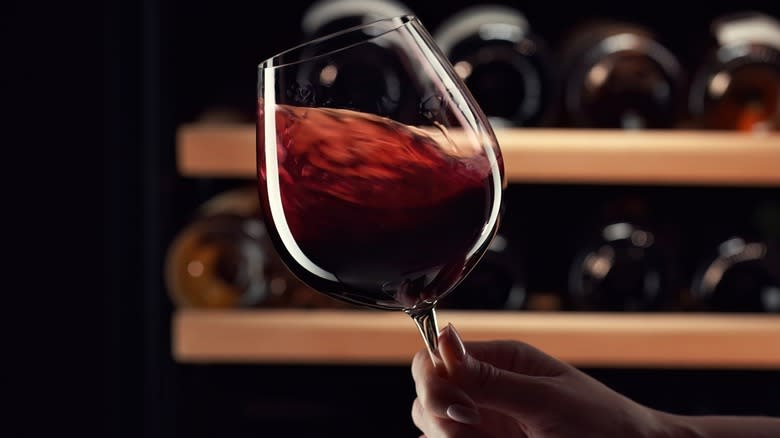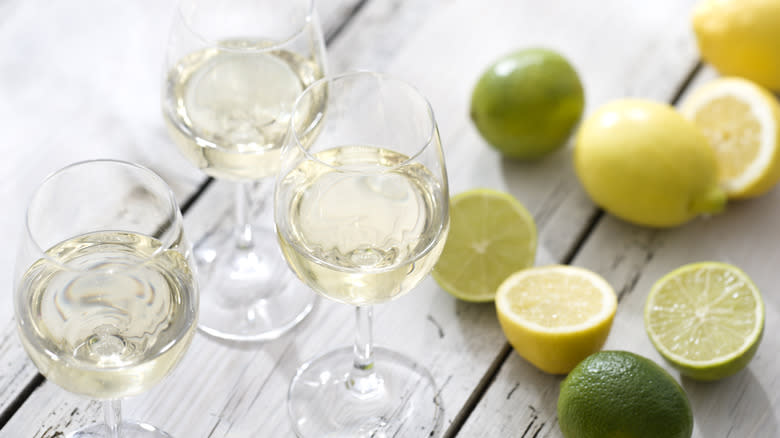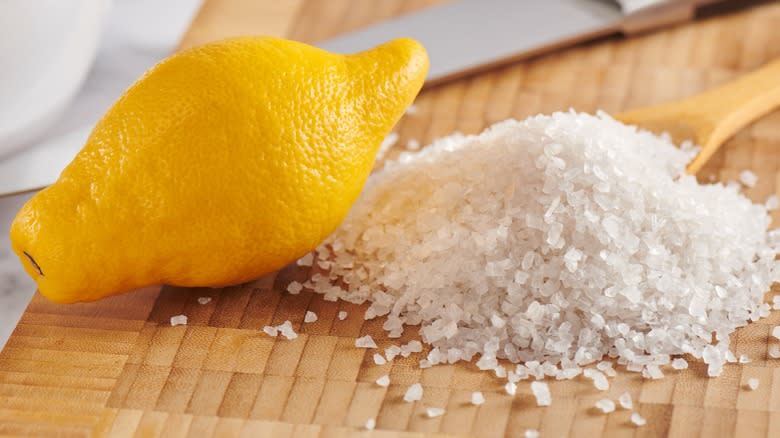The 2-Ingredient Trick For Boosting The Taste Of Your Next Glass Of Wine

If you're in the majority, you probably don't drink wine with anything added to it -- you just enjoy a nice glass of red, white, or rosé on its own. But others like the chill of a few ice cubes, the fizz of a bit of soda water, or even the festivity that fruit, brandy, and other liqueurs bring to a summertime wine sipper. (If that's you, check out our classic red sangria concoction.) But what if you really want to accentuate the myriad flavors and textures in your next glass of wine? Two surprising ingredients that you likely already have at home almost magically make the characteristics of wines more nuanced: salt and lemon juice.
If you're trepidatious, we feel you. It is quite the move to suggest stirring two such assertive ingredients into wine. So, let's unpack what makes this pairing work. First, we're not suggesting that you empty a packet of salt and squeeze a wedge of lemon directly into your next glass of Syrah or Vinho Verde. Rather, these ingredients are elements of a wine tasting meant to spotlight certain characteristics of the wine by accentuating or attenuating their properties. You might also think of this type of tasting as a wine experiment, whereby tasters sip a wine to gauge its base flavors before introducing a different element that alters the palate's perception of certain flavor components.
Read more: 13 Liquors Your Home Bar Should Have
What Can Salt And Lemon Juice Do For White Wine?

Erica Martinez at Food Republic has done a thorough review of how to enjoy a flavor-focused wine tasting. What you'll need are some wines, of course, but they do bear consideration. For this style of tasting, given that the goal is to observe the way external flavors affect the wine, it is best to choose a single white and red with bold flavors. Think high-acid types of white wine, such as Grüner Veltliner, and robust, tannic red wine types, like Petite Sirah. Also needed are ramekins of kosher salt and wedges of lemon.
Start with the fun part and have a sip of the white wine, taking time to notice how the acid expresses itself across the palate. High-acid white wine makes for a great food pairing, but it's important to know what to taste it with. Good money would be on opposites providing balance, but that's not the case, here. For evidence, now take a puckering lick of the lemon and chase it with a sip of wine. You'll likely notice that the acidity is more muted, which is why acidic wines pair so fabulously with acidic foods.
Salt, which is a known flavor booster, also has an interesting effect on white wine. Again, take an unadulterated sip of wine for a baseline. Then, with a damp finger, take a small lick of salt and let it melt over the tongue. Sip the wine again and study the acidity that seems to have disappeared as the wine has become smoother.
What Do Salt And Lemon Tame And Turn Up In Red Wine?

On the red front, start by taking a sip to appreciate the tannins that grip your tongue. They provide more of a structure or texture than a flavor, making up the body of hearty red wines. Repeat as with the white wine the lick of salt from your fingertip. Again sip the wine, and you may notice that those tannins have faded while the wine's fruit flavors have jumped to the forefront. The blend here of salt -- which is very present in foods, especially those on the menu of restaurants -- and wine is almost alchemical and sets up an understanding of why rich reds pair so well with meaty and well-seasoned dishes.
Acid, too, has a role to play in the perception of red wines, so move on to tasting the lemon alongside your glass of red. Take a blank sip before licking the lemon and having another sip of the red wine. Now, the tannins may burst to the forefront along with strong notes of fruit that outshine flavors like leather, wood, or tobacco.
A tasting like this is not only easy to set up but illuminates both the breadth of flavors in wines as well as how easily the palate can be influenced. While a single, inexpensive bottle of red and white will do, play around with the experiment and try it with other varietals and bottles you enjoy to see what flavor characteristics change.
Static Media owns and operates Tasting Table and Food Republic.
Read the original article on Tasting Table


